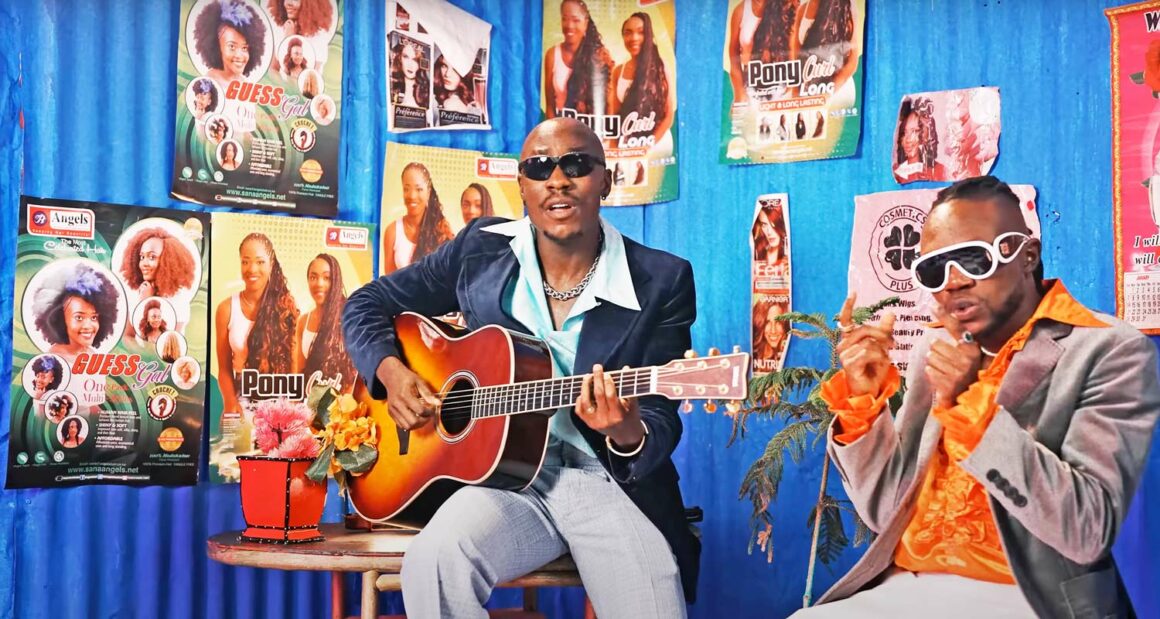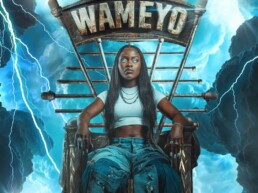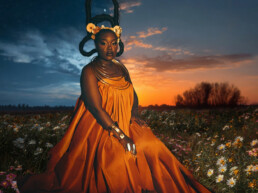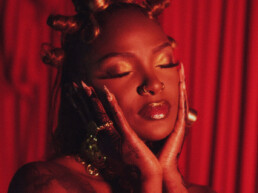Kisumu. On an evening in May 2025, the wind blows across Lake Victoria and over a large crowd gathered for a concert. The thousands in attendance are in awe, staring at the stage, everyone laser focused on the man in the spotlight, Coster Ojwang. The man of the moment stands there, dressed in a robe reminiscent of biblical times, a fly whisk similar to Kenya’s first president and a hat that reminds me of a ronin in feudal Japan, he holds the crowd’s attention at the tips of his fingers then suddenly, he breaks into song, crooning in his native Dholuo language and the crowd roars into life, following along word for word.
This was the Fisherman’s Experience by Coster Ojwang, a concert held in Kisumu, the Kenyan city on the shores of Lake Victoria. This region is predominantly inhabited by Nilotic peoples, the largest group being the Luo, of which Coster Ojwang is a member. The Fisherman’s Experience was more than just a concert. It was also a homecoming and a celebration of Coster and the success that he has enjoyed as a vernacular pop artist in Kenya.
Reject Tradition, Embrace Modernity
Popular Kenyan music began to veer towards more international influences during the turn of the millennium. Increased access to information and new experiences raised a generation that wasn’t particularly interested in their parents’ Mugithi, Benga or Rhumba that was on rotation at home. They grew up listening to Michael Jackson, Luther Vandross and Madonna, and they wanted to be just like them, international stars of glamour. The one-man guitars were replaced with open mic nights and keshas with karaoke.
These new activities and western genres became the rage all over Kenya, aided in part by the rise of young radio presenters such as Jimmy Gathu and Maina Kageni who were given the task of introducing new music to an audience that spanned all of Kenya. And with that, vernacular music took a back seat in the zeitgeist. Legendary bands such as D.O. Misiani and Shirati Jazz Band, who had dominated the 80s with their hits were relegated to playing in backwater bars and nightclubs in random towns, these venues often filled with older men come to relive their youth and reminisce about the good old days.
Post-Colonial Kenya continued with the colonial emphasis on the refusal of African culture and embracing the idea of the “British Gentleman” to whom speaking perfect English was the pinnacle of civilization, this idea endured and permeated for so many years and into so many strata of society that inevitably it crept into the arts and music scene. Artists who were making folk and vernacular music were seen as second class citizens, fluent in the languages of savagery.
For almost two decades, the sounds of Kenyan music were rarely ever influenced by vernacular genres. Of course there were the sprinklings of songs such as Ayub Ogada’s Koth Biro, Emmy Kosgei’s Taunet Nelel and Atoti by Gidi Gidi, Maji Maji and Wicky Mosh, that made the crossover from vernacular radio to the mainstream over the years but these were few and far between. There was a clear distinction within the music industry, that no matter how big the artist became, they would never be considered mainstream if their music was in a vernacular language.
Return from Exile
As the years passed, technology spread. It became easier than ever for people to interact with each other and the world around them. For the average Kenyan this meant that they finally got to see glimpses from parts of the country that had rarely ever gotten any of their attention. Social media connected all of us and music streaming put a billion songs right into people’s phones. With a touch of a button a Nairobian could listen to Japanese City Pop or Brazilian Baile Funk. Access was no longer an issue and discovery was now the challenge. Vernacular music in Kenya was no longer a reserve of the multitude of vernacular stations, now any artist could upload their music on the various streaming platforms and get their music to listeners all over the world. And with the rise of Africa-centric music services such as Mdundo and Boomplay, it became easier than ever for vernacular and folk artists to reach their audience.
As this shift in technology was happening, another cultural shift was occurring. While millennials had been quick to embrace westernized values at the turn of the millennium but the Gen Z who followed them were engaging in the opposite direction. They asked questions about their heritage, their cultural pride and identity. They held a desire to know more about the lives their grandparents lived, the stories of Kenya’s freedom fighters and their own cultural history. The dream of the English Gentleman had long been debunked and the new generation was eager to learn more about themselves and the people that came before them. And one of the most accessible ways to achieve this goal was through music and the arts. What started as an interest in their ancestral identities soon morphed into a meeting of cultures and generations that allowed for the growth and eventual explosion of vernacular pop into the mainstream Kenyan sound.
The notion that traditions and ancestral languages were reserved for the ‘uncultured’ was dead and buried. The internet had connected all of us and given us a chance to exhaustively get in touch with our roots. For a generation caught between two different worlds; raised with what many elders see as an alarming degree of freedom, yet still expected to uphold certain traditions, this was an opportunity to better understand themselves and shape their own identities.
Social media was a catalyst. A woman in Central Kenya could login to Facebook, lip syncing to Njata Yakwa, the wildly popular song by Kikuyu artist John De’Mathew, and the video would go viral. Thousands of comments would flood in, from fans of the artists saying how much they love the song, others stating the memories they associate with it and others just happy to discover a new song to listen to. The songs carried stories, memories, and culture and after years of being told that only western music mattered, it fueled a determination by both artists and fans to get in touch with their roots.

As undeniable as its influence was, social media alone wasn’t enough to bring about the change we see today. What truly accelerated the shift were more intentional acts, including a changing of the guard at radio stations, event spaces, and streaming platforms. This ushered in a new wave of curators (and gatekeepers) into the music industry. Young and with a fresh perspective on what Kenyan music could be, this new generation contrasted sharply with the old guard, who clung to the habit of prioritizing Western music to maintain a façade of being “metropolitan.” But the writing was on the wall: the new generation wasn’t interested in preserving that illusion. They were, and still are, willing to play any song on the radio, feature Kenyan vernacular pop music tracks on popular playlists, and showcase them on the biggest stages. In doing so, they’ve expanded the reach of Kenyan music and introduced it to new audiences, all while embracing a simple truth: a good song is a good song no matter the language it is in.
New Age Rockstars
With all these factors in play to promote Kenyan vernacular music there was a need for a bridge to connect the past and the present, a conduit to bring the sounds of the past into modernity. What was needed was a bunch of rockstars who spoke in the same diction and tone as your grandfather. Thankfully we found them.
These artists spun a modern take on Benga artistry. One of the first and most prominent artists to embrace the allure of vernacular and folk pop was Ayrosh, commonly referred to as “Mr Karikii Mani”. He realized he had a passion for telling African stories in a way that makes sense to Africans and as such began his career in the genre he calls “Folk Fusion”. He cites mugithi artists such as Salim Junior and John Kamaru as well as Afropop acts like Wizkid and Sauti Sol as some of his influences. This led him to find a space in between the two genres where he could fuse the best of both worlds, eventually coming up with Folk Fusion. He is famous for hit songs such as Wendo and Maheni.
Along with Ayrosh, there were others like Coster Ojwang. The much beloved “Fisherman”, is a multifaceted artist who is also a decorated contemporary painter, he fuses English and Swahili influences in his music together with his Luo culture to create a harmonious mix of sounds that have the fans paying close attention. In a music career that has spanned more than 5 years, the now 33 year old Coster has released three albums; Tales Of The Fisherman, Fweny (Revelations) and most recently ISNM which is an abbreviation for Imposter Syndrome No More. His most recent show in Kisumu drew thousands of fans.
The soul, for which music is made, is already fluent in the language of rhythm.
This Kenyan vernacular pop movement has seen the birth and mainstream success of many other artists such as Okello Max whose heartfelt lyrics and crooning voice has all the women swooning while he serenades them in Dholuo. Or Fadhilee Itulya who fuses contemporary elements with traditional Luhya sounds and instruments to give us an eclectic mish-mash of amazing music. From mainstream artists such as Watendawili and Savara to underground icons such as Wanjine, Udulele and Akoth Jumadi, it is clear that the era of looking at Kenyan vernacular music as something that was reserved for the old and those in the villages is dead and gone. There are many other such artists all over Kenya who are at the forefront, fusing the sounds of our tradition with the experiences and affordances of the modern world, all of them knowing well that the soul, for which music is made, is already fluent in the language of rhythm.
Hafare Segelan
Hafare Segelan is a music writer, critic, curator and content creator who is the brainchild behind two popular podcasts, Surviving Nairobi and Breaking Hertz. His work has been featured on platforms such as Spotify, Apple Podcasts, The BBC and many more. You can find him on Bluesky as @hafare.bsky.social
1 Comment
Comments are closed.





Akoth Jumadi should be a bigger star than she is aki